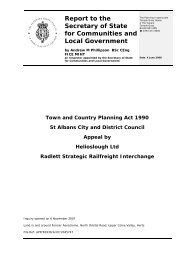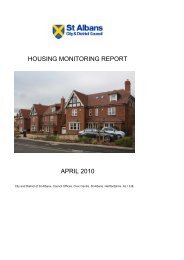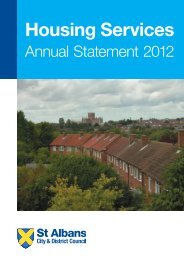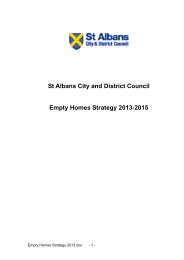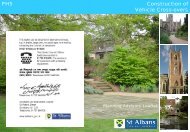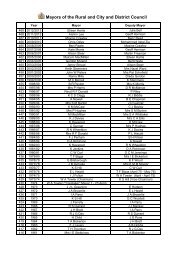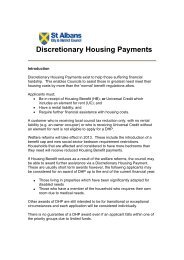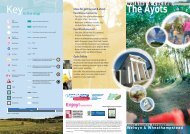Planning and renewable energy - St Albans City & District Council
Planning and renewable energy - St Albans City & District Council
Planning and renewable energy - St Albans City & District Council
Create successful ePaper yourself
Turn your PDF publications into a flip-book with our unique Google optimized e-Paper software.
PH29<br />
<strong>Planning</strong> <strong>and</strong> Renewable Energy<br />
<strong>Planning</strong> Advisory Leaflet
PLANNING AND RENEWABLE ENERGY<br />
1. Introduction<br />
The release of greenhouse gases into the atmosphere is now<br />
widely acknowledged to be a significant contributor to climate<br />
change. Carbon dioxide released by the combustion of fossil fuels<br />
for electricity generation, producing heat or as a fuel for transport is<br />
the major source of man-made greenhouse gases. There are two<br />
main ways of combating this, namely reducing <strong>energy</strong> dem<strong>and</strong><br />
through efficiency of use <strong>and</strong> using alternative low carbon or<br />
<strong>renewable</strong> <strong>energy</strong> supplies.<br />
The UK is committed to meeting a significant proportion of our<br />
<strong>energy</strong> needs from <strong>renewable</strong> <strong>energy</strong> sources. Government targets<br />
are to generate 10% of the nation’s electricity from <strong>renewable</strong>s by<br />
2010, 15% by 2015 <strong>and</strong> 20% by 2020. Nationally, in 2003 only 4%<br />
of our electricity was obtained from <strong>renewable</strong> sources.<br />
On a regional level, in 2001 the East of Engl<strong>and</strong> only produced<br />
0.45% of its dem<strong>and</strong> from <strong>renewable</strong> sources. All regions were<br />
asked by the Government to set targets for themselves up to 2010<br />
<strong>and</strong> the East of Engl<strong>and</strong> adopted the figure below, which was<br />
detailed in the Draft East of Engl<strong>and</strong> Regional Spatial <strong>St</strong>rategy<br />
(RSS), published in December 2004.<br />
To produce 14% of the region’s electricity from <strong>renewable</strong><br />
sources by 2010 (including offshore wind, 10% if offshore wind<br />
is excluded).<br />
This regional target was then dissected into county targets, <strong>and</strong><br />
153,000 Megawatt hours per year were proposed for<br />
Hertfordshire. This figure equates to only 3% of Hertfordshire’s<br />
predicted <strong>energy</strong> consumption in 2010.<br />
In an effort to find ways of meeting this target, Hertfordshire County<br />
<strong>Council</strong> <strong>and</strong> all 10 <strong>District</strong> <strong>Council</strong>s in the county commissioned<br />
specialist consultants to produce a report setting out what <strong>and</strong><br />
where the potential was in Hertfordshire for <strong>renewable</strong> <strong>energy</strong><br />
development.<br />
The conclusions of this report were that Hertfordshire did have the<br />
potential to meet its target, but only if new <strong>and</strong> existing development<br />
started to implement <strong>renewable</strong> <strong>energy</strong> technologies as soon as<br />
possible. One key barrier to this happening was identified as the<br />
lack of positive planning policies encouraging <strong>renewable</strong> <strong>energy</strong><br />
technologies.<br />
Government guidance in <strong>Planning</strong> Policy <strong>St</strong>atement (PPS) 22<br />
provides local authorities with the backing to encourage <strong>and</strong> require<br />
<strong>renewable</strong> <strong>energy</strong> technology in development through their Local<br />
Development Frameworks.<br />
In October 2006, the <strong>Council</strong>’s <strong>Planning</strong> Policy Advisory Panel<br />
agreed that a good practice planning guidance leaflet should be<br />
produced to initiate <strong>St</strong> <strong>Albans</strong> <strong>City</strong> <strong>and</strong> <strong>District</strong> <strong>Council</strong>’s contribution<br />
to the county target, whilst also protecting our historic built<br />
environment. It was also considered necessary to provide planning<br />
guidance to homeowners wishing to install small-scale domestic<br />
schemes, which are becoming more popular <strong>and</strong> widely available.<br />
2. What is <strong>renewable</strong> <strong>energy</strong>?<br />
The definition of <strong>renewable</strong> <strong>energy</strong> covers those <strong>energy</strong> flows that<br />
occur naturally <strong>and</strong> repeatedly in the environment. These are the<br />
wind, the fall of water, the movement of the oceans, <strong>energy</strong> from<br />
the sun <strong>and</strong> also from biomass (the burning of crops to generate<br />
various fuel types). Below is a brief guide to the types of <strong>renewable</strong><br />
<strong>energy</strong> that may be suitable for <strong>St</strong> <strong>Albans</strong> <strong>District</strong>.<br />
Wind<br />
The United Kingdom is the windiest part of Europe <strong>and</strong> there are<br />
currently 1,400 operational wind turbines providing electricity for<br />
over 700,000 homes, therefore reducing carbon dioxide emissions<br />
by three million tonnes per year. Whilst there is little potential within<br />
<strong>St</strong> <strong>Albans</strong> <strong>District</strong> for large scale wind turbines, there is a significant<br />
opportunity for small-scale domestic turbines to be integrated into<br />
both existing <strong>and</strong> new build development.<br />
1<br />
2
Biomass<br />
Small-scale biomass heat facilities are a relatively straightforward<br />
process for domestic <strong>and</strong> commercial heat-only projects. The<br />
process involves the burning of a fuel crop (eg short rotation willow<br />
coppice) to provide heat. Many public buildings, for example<br />
schools <strong>and</strong> colleges, have utilised such technology, attracting good<br />
levels of grant funding. Unused materials from forestry operations<br />
(eg small branches <strong>and</strong> bark) can also be used as biomass fuel,<br />
along with some waste materials unsuitable for recycling (eg timber<br />
offcuts, sawdust, shredded confidential documents etc).<br />
Solar Photovoltaic (PV)<br />
Solar PV panels only require daylight, not direct sunlight, to<br />
generate electricity. They are a flexible technology that can either<br />
be connected to the National Grid or be st<strong>and</strong>-alone. As such, they<br />
can be suitable for both urban <strong>and</strong> rural locations.<br />
Solar Water Heating<br />
Solar hot water systems use heat from the sun to provide homes<br />
with hot water. There are two main types of system, either a flat<br />
panel collector or an evacuated tube where water is heated directly<br />
by the sun in a series of tubes attached to a frame.<br />
Ground Source Heat Pumps (GSHP)<br />
GSHPs transfer heat from the ground into a building to provide<br />
space heating <strong>and</strong> in some cases to pre-heat domestic hot water.<br />
The system is ideal for new build <strong>and</strong> there are no planning issues<br />
given the underground nature of the system.<br />
Biofuels<br />
Biofuels offer a potential alternative to conventional vehicle fuels<br />
although, in order to make a major contribution, they would require<br />
large areas of l<strong>and</strong>. Biodiesel can be made from oil-seed rape;<br />
whilst bio-ethanol suitable for use in modified petrol engines can be<br />
produced from sugar beet or cereals.<br />
3. What <strong>St</strong> <strong>Albans</strong> <strong>City</strong> <strong>and</strong> <strong>District</strong> <strong>Council</strong> is doing?<br />
The <strong>Council</strong> is committed to playing an active role in helping to<br />
reduce carbon emissions <strong>and</strong> meet <strong>renewable</strong> <strong>energy</strong> targets. As a<br />
result, the <strong>Council</strong> is aiming to achieve a significant reduction in<br />
domestic carbon dioxide emissions across the <strong>District</strong> by 2010. A<br />
recent <strong>energy</strong> audit of the <strong>Council</strong> Offices highlighted the potential<br />
for a 20% reduction in <strong>energy</strong> consumption <strong>and</strong> measures are being<br />
put in place for this to be achieved.<br />
The <strong>Council</strong> has also been involved in a number of <strong>renewable</strong><br />
<strong>energy</strong> projects across the <strong>District</strong>. A solar hot water system has<br />
been installed at ‘Inn on the Park’ in Verulamium Park that provides<br />
hot water for washing <strong>and</strong> cleaning, whilst a 5 kilowatt solar<br />
Photovoltaic system has been installed at Jersey Farm Community<br />
Centre to generate electricity <strong>and</strong> reduce the centre’s overall<br />
dem<strong>and</strong> for <strong>energy</strong>.<br />
A wide variety of <strong>energy</strong> efficiency <strong>and</strong> <strong>renewable</strong> <strong>energy</strong><br />
technologies are showcased at the <strong>Council</strong>’s popular ‘Eco-house’ in<br />
Sleapshyde (see opposite), <strong>and</strong> financial assistance is also<br />
available to <strong>District</strong> homeowners wishing to install their own solar<br />
hot water systems (see Section 8 – Grants).<br />
The publication of this good practice planning guidance leaflet is<br />
intended to assist the <strong>Council</strong> <strong>and</strong> its residents in tackling climate<br />
change. This leaflet provides guidance covering three specific<br />
areas, namely <strong>energy</strong> efficiency, <strong>renewable</strong> <strong>energy</strong> in new<br />
development, <strong>and</strong> domestic installations. The <strong>Council</strong> will<br />
encourage all relevant applications from 1 December 2006 to meet<br />
the criteria detailed in each specific area.<br />
3<br />
4
4. Energy efficiency<br />
The easiest way to conserve the diminishing fossil fuels is to use<br />
less <strong>energy</strong> in the first place, <strong>and</strong> that we use <strong>energy</strong> more<br />
efficiently. The <strong>Council</strong> attaches great importance to future<br />
development becoming more <strong>energy</strong> efficient, as this is central to<br />
the principles of sustainable development.<br />
Part L of the Building Regulations that came into force in April 2006<br />
covers some aspects of <strong>energy</strong> efficiency through design <strong>and</strong><br />
layout.<br />
When submitting planning applications, developers are encouraged<br />
to demonstrate how the scheme has been designed to help<br />
conserve <strong>energy</strong>. The good practice measures below should be<br />
applicable to all new development <strong>and</strong> also conversion schemes.<br />
SADC ‘Eco-house’ in Sleapshyde<br />
Energy efficiency<br />
The <strong>Council</strong> will encourage all developments to:<br />
<br />
<br />
<br />
achieve a high st<strong>and</strong>ard of <strong>energy</strong> efficiency through the<br />
use of appropriate siting, design, orientation <strong>and</strong> layout;<br />
maximise the benefits of passive solar heating, cooling,<br />
lighting <strong>and</strong> natural ventilation;<br />
use materials from local sustainable sources, including the<br />
re-use of materials.<br />
5<br />
5. Renewable <strong>energy</strong><br />
PPS22 confirms the Government’s commitment to embracing<br />
<strong>renewable</strong> <strong>energy</strong> by encouraging local planning authorities (LPAs)<br />
to incorporate relevant policies in their Local Development<br />
Frameworks (LDFs). The document states that LPAs should<br />
consider the opportunity for incorporating <strong>renewable</strong> <strong>energy</strong><br />
projects in all new developments, <strong>and</strong> encouragement should be<br />
given in positively expressed policies. <strong>St</strong> <strong>Albans</strong> <strong>City</strong> <strong>and</strong> <strong>District</strong><br />
<strong>Council</strong> will include policies on <strong>renewable</strong> <strong>energy</strong> in its<br />
Development Plan Documents (DPDs), which will form the main<br />
part of the LDF.<br />
6
In December 2006, the Secretary of <strong>St</strong>ate published the Proposed<br />
Changes to the Draft East of Engl<strong>and</strong> Plan. Policy ENG 1 (Carbon<br />
Dioxide <strong>and</strong> Energy Performance) in the Proposed Changes<br />
document includes the following guidance:<br />
‘Local Authorities should encourage the supply of <strong>energy</strong> from onsite<br />
<strong>renewable</strong> <strong>and</strong>/or decentralised <strong>renewable</strong> or low carbon<br />
<strong>energy</strong> sources <strong>and</strong> through DPDs set ambitious but viable<br />
proportions of the <strong>energy</strong> supply of substantial new development<br />
(as defined in the <strong>Planning</strong> Policy <strong>St</strong>atement on <strong>Planning</strong> <strong>and</strong><br />
Climate Change) from these sources. In the interim as a minimum,<br />
10% of the <strong>energy</strong> consumed in new development should come<br />
from such sources. To help realise higher levels of ambition, local<br />
authorities should encourage <strong>energy</strong> service companies (ESCOs)<br />
<strong>and</strong> similar <strong>energy</strong> saving initiatives.’<br />
The East of Engl<strong>and</strong> Plan is due to be finalised in early 2008 <strong>and</strong> it<br />
will then form part of the development plan.<br />
In advance of the LDF, the guidance below introduces an<br />
encouragement for all major planning applications to provide on-site<br />
<strong>renewable</strong> <strong>energy</strong> technology to meet a proportion of predicted<br />
<strong>energy</strong> generation.<br />
Renewable Energy<br />
The <strong>Council</strong> will encourage all types of new development, either<br />
new build or conversion, above a threshold of 1,000 square metres<br />
(for non-residential development) or 10 dwellings (for residential<br />
development) to:<br />
incorporate equipment for on-site <strong>renewable</strong> <strong>energy</strong><br />
generation that will meet at least 10% of the development’s<br />
predicted <strong>energy</strong> requirements.<br />
This proportion of <strong>energy</strong> production could include <strong>energy</strong> from<br />
wind, biomass, photovoltaic equipment, solar hot water heating or<br />
ground source heat pumps.<br />
6. Domestic installations<br />
The consultants’ report that looked into the <strong>renewable</strong> <strong>energy</strong><br />
potential in Hertfordshire identified domestic scale schemes as<br />
most appropriate for the county. <strong>St</strong> <strong>Albans</strong> <strong>City</strong> <strong>and</strong> <strong>District</strong> is<br />
characterised by its historic built environment, with a large number<br />
of listed buildings <strong>and</strong> conservation areas in existence. These<br />
designations serve to preserve <strong>and</strong> enhance the character of the<br />
buildings <strong>and</strong> surrounding area. Certain <strong>renewable</strong> <strong>energy</strong><br />
schemes, for example solar panels, can have a significant visual<br />
impact on a building; therefore a more careful approach is<br />
necessary <strong>and</strong> in some cases such installations will not be<br />
permitted.<br />
The good practice below offers clear guidance on how such<br />
technologies can best be implemented on domestic properties <strong>and</strong><br />
in designated areas. As detailed in Section 7, not all installations<br />
require planning consent.<br />
Domestic installations<br />
The <strong>Council</strong> encourages the installation of residential <strong>renewable</strong><br />
<strong>energy</strong> projects that are encouraged to follow the guidelines<br />
below:<br />
<br />
<br />
Green Belt – When located in the Green Belt, many<br />
<strong>renewable</strong> <strong>energy</strong> projects will comprise inappropriate<br />
development, which may adversely impact on the openness<br />
of the Green Belt. Careful consideration will therefore be<br />
given by the <strong>Council</strong> to the visual impact of projects, <strong>and</strong><br />
applicants will need to demonstrate very special<br />
circumstances that clearly outweigh any harm if projects are<br />
to proceed. This may include the wider environmental<br />
benefits associated with increased production from<br />
<strong>renewable</strong> sources.<br />
Solar panels – Panels located on rear roof slopes or out of<br />
public view will be favoured. Those having a serious<br />
detrimental impact on the visual appearance of a property<br />
should be avoided. Panels installed flush within the roof<br />
plane will also be favoured.<br />
7<br />
8
Micro Wind turbines – As with satellite dishes, micro wind<br />
turbines should be positioned in such a way to minimise the<br />
visual impact on the external appearance of the building.<br />
Locations behind a parapet or shielded by a chimneystack<br />
are likely to be less conspicuous than a position somewhere<br />
on the front of the building. Potential noise disruption to<br />
adjoining occupiers will also be a consideration.<br />
Within Conservation Areas – Inconspicuous positions for<br />
installations are encouraged. In particular, panels <strong>and</strong><br />
turbines should not be erected on the front roof slope or<br />
façade of a property. Unsympathetic alterations that<br />
damage the historic street scene should be avoided.<br />
Within Article 4 areas <strong>and</strong> on Listed Buildings – Installations<br />
anywhere on the roofslope or the building itself should not<br />
have a detrimental visual impact. In such cases, preference<br />
will be given to panels or turbines sited elsewhere in the<br />
grounds, subject to there being no material adverse visual<br />
or physical intrusion into the character of the area or<br />
building.<br />
7. Do I need planning permission?<br />
Section 6 offers guidance to householders wishing to install<br />
<strong>renewable</strong> <strong>energy</strong> technologies on their property. The majority of<br />
houses in the <strong>District</strong> benefit from ‘permitted development’ rights.<br />
These rights give householders the opportunity to extend <strong>and</strong> alter<br />
their house to a certain extent <strong>and</strong> subject to certain provisos,<br />
without the need for planning permission. The <strong>Council</strong> has protected<br />
some particularly sensitive parts of Conservation Areas by<br />
withdrawing most permitted development rights using an ‘Article 4’<br />
direction. In these areas there are very limited permitted<br />
development rights. Listed buildings are also subject to special<br />
controls over development <strong>and</strong> other alterations. If you wish to<br />
ascertain whether your property falls within one of these special<br />
categories, please contact the Conservation <strong>and</strong> Design Team on<br />
01727 866100 x 2616.<br />
It should be noted that the Government is proposing to alter the<br />
existing permitted development rights for householders to enable<br />
certain small-scale <strong>renewable</strong> <strong>energy</strong> technologies to be erected<br />
without the need for planning consent. Any changes are likely to<br />
come into force in 2007 <strong>and</strong> would supersede the guidance detailed<br />
above <strong>and</strong> below.<br />
Even before these changes to permitted development rights are<br />
made, it may be that some small-scale <strong>renewable</strong> <strong>energy</strong><br />
developments can be implemented under current permitted<br />
development rights. Given the lack of specific Government<br />
guidance, it is not possible to provide an answer for every property<br />
<strong>and</strong> every potential <strong>renewable</strong> scheme; however, below is a general<br />
guide as to what kind of domestic <strong>renewable</strong> <strong>energy</strong> developments<br />
the <strong>Council</strong> considers require planning permission.<br />
<strong>Planning</strong> consent is not required for:<br />
<br />
<br />
any solar panels on the roof slope of domestic properties that<br />
do not project more than 100mm above the roof plane (unless<br />
the <strong>Council</strong> considers the appearance of a building has<br />
significantly changed);<br />
micro wind turbines under 90cm in diameter <strong>and</strong> below the<br />
ridge of the roof on domestic properties.<br />
<strong>Planning</strong> consent is required for<br />
<br />
<br />
<br />
<br />
any solar panels protruding more than 100mm above the<br />
existing roof plane;<br />
micro wind turbines protruding above the highest point of the<br />
existing roof or over 90cm in diameter;<br />
any solar panels or micro wind turbines on properties within an<br />
Article 4 area or where permitted development rights have<br />
been removed;<br />
any solar panels or micro wind turbines on or adjacent to a<br />
listed building.<br />
As a general rule, any scheme that is considered to significantly<br />
change the appearance of a building will require planning consent.<br />
An example would be the installation of solar panels across an<br />
entire roof slope, even if they did not protrude more than 100mm.<br />
9<br />
10
Classes B <strong>and</strong> C of the General Permitted Development Order<br />
1995 cover the majority of domestic <strong>renewable</strong> <strong>energy</strong><br />
developments. For further advice as to whether a specific proposal<br />
would require consent, please contact our <strong>Planning</strong> Development<br />
Control Team on 01727 819344 or 819345. It is always advisable to<br />
check with the <strong>Council</strong> before proceeding with any development.<br />
8. Grants <strong>and</strong> other information<br />
The <strong>Council</strong> is currently running the ‘Life in the Green Lane’<br />
scheme, which will provide the opportunity for up to 100 private<br />
households to install a domestic solar hot water system at a<br />
substantially reduced cost. Grant funding has been obtained from<br />
the Energy Saving Trust <strong>and</strong> more details are available either on<br />
the <strong>Council</strong>’s website at www.stalbans.gov.uk or from the Energy<br />
Officer, contact details below.<br />
Central Government’s Low Carbon Buildings Programme offers<br />
grants for a range of <strong>renewable</strong> <strong>energy</strong> technologies. The<br />
programme provides grants for microgeneration technologies to<br />
householders, community organisations, schools <strong>and</strong> the public.<br />
The grants are not available for the profit sector <strong>and</strong> private<br />
businesses. To find out more about the programme, the<br />
technologies it covers <strong>and</strong> how to apply, please visit<br />
www.lowcarbonbuildings.org.uk.<br />
The Government department, Communities <strong>and</strong> Local Government,<br />
have published the ‘Code for Sustainable Homes’, a rating system<br />
that applies to new homes. The Code encourages home builders to<br />
go beyond Building Regulations in terms of <strong>energy</strong> efficiency <strong>and</strong><br />
low carbon design, <strong>and</strong> ultimately supports the Government’s<br />
aspiration for all new homes to be ‘zero carbon’ by 2016. Although<br />
the new code is currently voluntary, it is likely that will become<br />
m<strong>and</strong>atory in 2009. More information can be obtained from the<br />
department’s website: www.communities.gov.uk.<br />
9. Useful Contacts<br />
Energy Officer, SADC<br />
Tel: 01727 866100 x2380<br />
Email: sustainability@stalbans.gov.uk<br />
<strong>Planning</strong> Policy Officer, SADC<br />
Tel: 01727 866100 x2736<br />
Email: planningpolicy@stalbans.gov.uk<br />
Conservation Officer, SADC<br />
Tel: 01727 866100 x2616<br />
Email: planning@stalbans.gov.uk<br />
Energy Saving Trust<br />
Tel: 0800512012<br />
Website: www.est.org.uk<br />
Further information<br />
This advisory leaflet is intended to be a helpful <strong>and</strong> useful source of<br />
information <strong>and</strong> not binding on any party. The <strong>Council</strong> offers no<br />
guarantee or warranties concerning the accuracy of the information<br />
supplied.<br />
For more information about the contents of this leaflet contact:<br />
The <strong>Planning</strong> Department<br />
<strong>St</strong> <strong>Albans</strong> <strong>City</strong> <strong>and</strong> <strong>District</strong> <strong>Council</strong><br />
<strong>St</strong> Peter’s <strong>St</strong>reet<br />
<strong>St</strong> <strong>Albans</strong>, Hertfordshire AL1 3JE<br />
Telephone: 01727 819344 or 819345<br />
Website: www.stalbans.gov.uk<br />
Produced by <strong>St</strong> <strong>Albans</strong> <strong>City</strong> <strong>and</strong> <strong>District</strong> <strong>Council</strong><br />
Issued August 2007. PH29(a)<br />
11<br />
12



